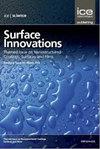Synthesis of quaternized chitosan and its application in cotton as wound dressing material
IF 3.5
4区 材料科学
Q3 CHEMISTRY, PHYSICAL
引用次数: 0
Abstract
The antimicrobial and hemostatic activities of wound dressing drew more and more attention in the healthcare or medical industry. Here, the quaternary ammonium groups were introduced in the chitosan backbone via co-polymerization, and the quaternized chitosan was coated on the cotton fabric through the PDC process. Compared with BPTCD treated cotton (cotton/BPTCD), the breaking strength of CS-b-pSBMA coated cotton (cotton/SBMA) have not affected by the addition of CS-b-pSBMA. The SBMA coated cotton displayed good liquid adsorptive activity with or without pressure. As a dressing material, cotton/SBMA exhibited good hemostatic activity and hemocompatibility. After being challenged with E. coli O157:H7 and S. aureus for 60 min, cotton/SBMA showed good antimicrobial properties, and 100% bacteria was inhibited within the contact time. These attractive functions make the quaternized chitosan-coated cotton fabrics a good candidate for wound dressing materials.季铵化壳聚糖的合成及其在棉花创面敷料中的应用
伤口敷料的抗菌和止血活性在医疗保健行业引起了越来越多的关注。本文通过共聚合将季铵基团引入壳聚糖骨架中,并通过PDC工艺将季铵化的壳聚糖涂覆在棉织物上。与BPTCD处理棉(棉/BPTDD)相比,CS-b-pSBMA涂层棉(棉/SBMA)的断裂强度不受CS-b-pSBMA添加量的影响。SBMA涂层棉在有压力或无压力条件下均表现出良好的液体吸附活性。作为敷料材料,棉/SBMA表现出良好的止血活性和血液相容性。用O157:H7大肠杆菌和金黄色葡萄球菌攻击60天后 min,棉/SBMA显示出良好的抗菌性能,在接触时间内100%抑制细菌。这些吸引人的功能使季铵化壳聚糖涂层棉织物成为伤口敷料材料的良好候选者。
本文章由计算机程序翻译,如有差异,请以英文原文为准。
求助全文
约1分钟内获得全文
求助全文
来源期刊

Surface Innovations
CHEMISTRY, PHYSICALMATERIALS SCIENCE, COAT-MATERIALS SCIENCE, COATINGS & FILMS
CiteScore
5.80
自引率
22.90%
发文量
66
期刊介绍:
The material innovations on surfaces, combined with understanding and manipulation of physics and chemistry of functional surfaces and coatings, have exploded in the past decade at an incredibly rapid pace.
Superhydrophobicity, superhydrophlicity, self-cleaning, self-healing, anti-fouling, anti-bacterial, etc., have become important fundamental topics of surface science research community driven by curiosity of physics, chemistry, and biology of interaction phenomenon at surfaces and their enormous potential in practical applications. Materials having controlled-functionality surfaces and coatings are important to the manufacturing of new products for environmental control, liquid manipulation, nanotechnological advances, biomedical engineering, pharmacy, biotechnology, and many others, and are part of the most promising technological innovations of the twenty-first century.
 求助内容:
求助内容: 应助结果提醒方式:
应助结果提醒方式:


